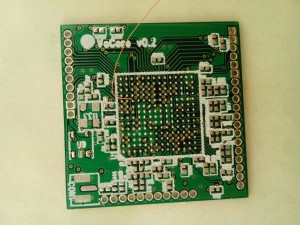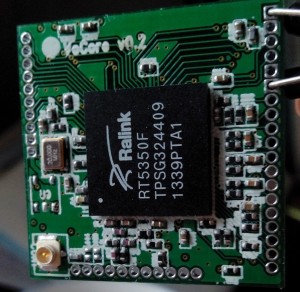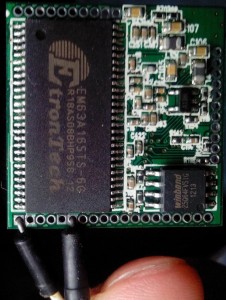I am a real newbie on hardware 🙂
VoCore 0.2 has failed, when I connect it to power, some time the current cost is 0.20A but some time the current cost is 0.23A and RXD2/TXD2 is always high, it should change to low once the chip on boot process. So I guess the problem is before bootstrap, and the problem might be I floated PORST_N which is used to reset the chip.
For v0.2, I just simply followed the datasheet of RT5350F and trust its “internal pull up”. But in fact, reset can not work that easy way. it will be pull high once it connect to 3.3V then it will be pull low for a few ms(140ms~400ms), so if I just pull it to high will cause problem.
OK, then I jump a wire under BGA as following. Plan to connect a chip named MAX809S, it is a reset circuit. It is used to make reset stable.
Then solid all parts on. Then do a few test…
Connect to power, now it current consume is fixed to 0.20A, not float between 0.20A ~ 0.23A anymore. So I think at least the reset part is normal now.
Connect with TXD2 to a PL2302 USB-TTL device, I find TXD2 changed to low after boot, so boot strap is normal.
Then I try to read from the chip, no luck, nothing output. I tried many times, but no success. Only one time it output some REAL char when I press the memory hard onto the board(I am so happy when I get that output, it is close to success). I think there must be something wrong on the memory. Then I use ohmmeter to check between memory solid pad and memory chip foot, find at least 5 feet are not really connected to the pad. For fix that, I tried to use the high skill called “drag-soldering”, but just make my board into mess… and I lose one memory chip. 🙂
Another try is to solid another board, but this time BGA has some problem because of the jump wire. I have to stop here, or I will lose more RT5350F. :'(
For next step, I’d better to make another board, then use the “print-solid” way, much easier for a newbie and that will have high rate to success.
Show my current work.


